Moss
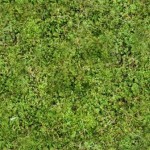
Moss is generally caused by:
– Compact Soil
– Sour Soil
– Over-wet Soil
– Too much shade
– Improper fertilisation.
The problem can be corrected through a process of elimination. Until the cause is eliminated, moss will continue to grow in the affected area.
Raking the affected area only removes the dead moss and does not cure the problem. There are several moss-killers available on the market (contact your local garden centre). Most moss-killers will turn the moss black in a short period of time. Once it has turned black rake it out of the grass, you may need to treat the affected area twice to completely kill off the moss. Once the area has been cleared of moss you can then prepare to over-seed.
Toadstools
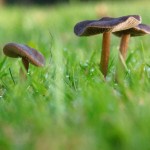
It is very common for small brown toadstools to appear in recently laid cultivated turf. They are not damaging to the turf and are a temporary issue.
The harvesting process of cultivated turf causes damage to the root system and underground part of the turf. Microscopic bacteria and fungi, present in all soil decomposes the dead and dying tissue on the turf once it has been laid. This process of biological decomposition, which breaks down organic matter, occurs naturally throughout the garden. Once the dead material in the turf has gone, the toadstools will go as well. It is unusual for toadstools to return again.
For most of the fungi life cycle it remains too small to even see, however under certain weather conditions fungi move into their reproductive phase and produce small brown toadstools. Spores are then released from the toadstools and are carried along on the wind. Toadstools are more commonly seen in warmer weather. When you water your newly installed turf you are creating an ideal warm, moist microclimate for the fungus that produces the toadstools to grow. If turf is laid in cold weather the fungi will not appear until the temperature rises and conditions are moist.
As a precaution we strongly advise that you keep children away from the toadstools as they may be harmful if eaten, as is the case with many things found in your garden. At present there are no fungicides recommended, however there really is no need to treat them, as they are not damaging to the turf and are part of a natural temporary process. If you are worried about children eating them, the simplest way to remove the toadstools from the lawn is by mowing the affected area until no more are produced, or alternatively, by brushing them off, this allows them to dry out and will disappear.
Leatherjackets
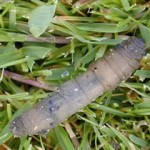
Leatherjackets are the larvae of the crane fly (commonly known as daddy long legs). The grubs are legless, grey/brown without a distinct head and they usually grow to a maximum of 30-40mm. In late summer the female lays up to 300 eggs in grassy areas and they then hatch into leatherjackets. They stay under ground over winter and cause most damage to the turf in the following spring before hatching. When they do hatch you will notice small black pods in your lawn, and lots of crane flies emerging.
The insect larvae feed mainly on the roots of the turf. This results in straw like patches of turf appearing, which later become bare and invaded by weeds.
The best time to treat for leatherjackets is in the autumn when the larvae are small and soft, rather than in spring when they are tougher. Your local garden centre should be able to advise on a suitable insecticide, or you can use a more eco friendly method.
1. Soak the lawn area
2. Apply black plastic bags and pin down with stones/bricks
3. Leave overnight
4. Remove the black bags in the morning
5. You will notice that the leatherjackets have come to the surface
6. Sweep the grubs up and put on your bird table
Do not feed the grubs to the birds if you have used an insecticide.
Chafer Grubs
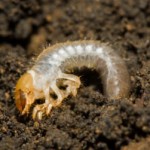
Chafer grubs are the larvae (grub) of chafer beetles. They live just beneath the surface of lawns feeding on the roots of the grass plants. In removing the roots, the chafer grub leaves a tell-tale sign of its existence by causing small areas of the lawn (the size of a £2 coin up to that of a small tea plate) to begin to brown off and die, making the grass very easy to pull up. Another more destructive sign most people notice is birds, moles or foxes peck at the lawn to get at the grubs. Chafer grubs are often confused with leatherjackets and accurate identification is important to ensure the correct treatment is used. If you find an area you suspect is suffering due to chafer grubs, gently pull up and peel back the effected grass, and dig no more than a couple of cm into the soil.
You should find the grub within this depth of the surface. It is possible that the grub has moved or been eaten by an animal so try a few of the affected areas. The key difference between a chafer grub and a leatherjacket is that chafer grubs have legs close to the red head.
Pets
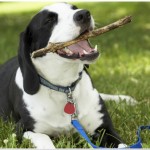
Although they are said to be ‘mans best friend’, they can do a lot of damage to your lovely manicured lawn. Urine contains chemicals that can permanently damage grass lawns. Tell tale signs are brown circular patches with healthy grass surrounding. This will be most visible in dry weather.
The only treatment is to plentifully water the affected patches. In extreme cases, re-turfing may be your only option.
Red Thread
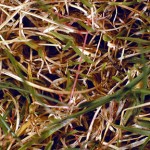
Red thread is one of the most common fungal patch diseases found on lawns, particularly where the turf is deficient in nitrogen. It causes brown patches of turf, especially during a wet summer. The threat from red thread can be reduced by taking action to improve the drainage and aeration of the turf. Scarifying the turf with a lawn rake or scarifier will remove thatch and moss and increase aeration. Poor drainage and compacted areas can be alleviated by forking or by the use of a solid-tine or hollow-tine aerator. Ensure that the soil is not deficient in nitrogen. Disposing of grass cuttings will reduce the amount of fungus present to re-infect the lawn.
If red thread appears, application of nitrogen to the affected area will often be sufficient to control it.
